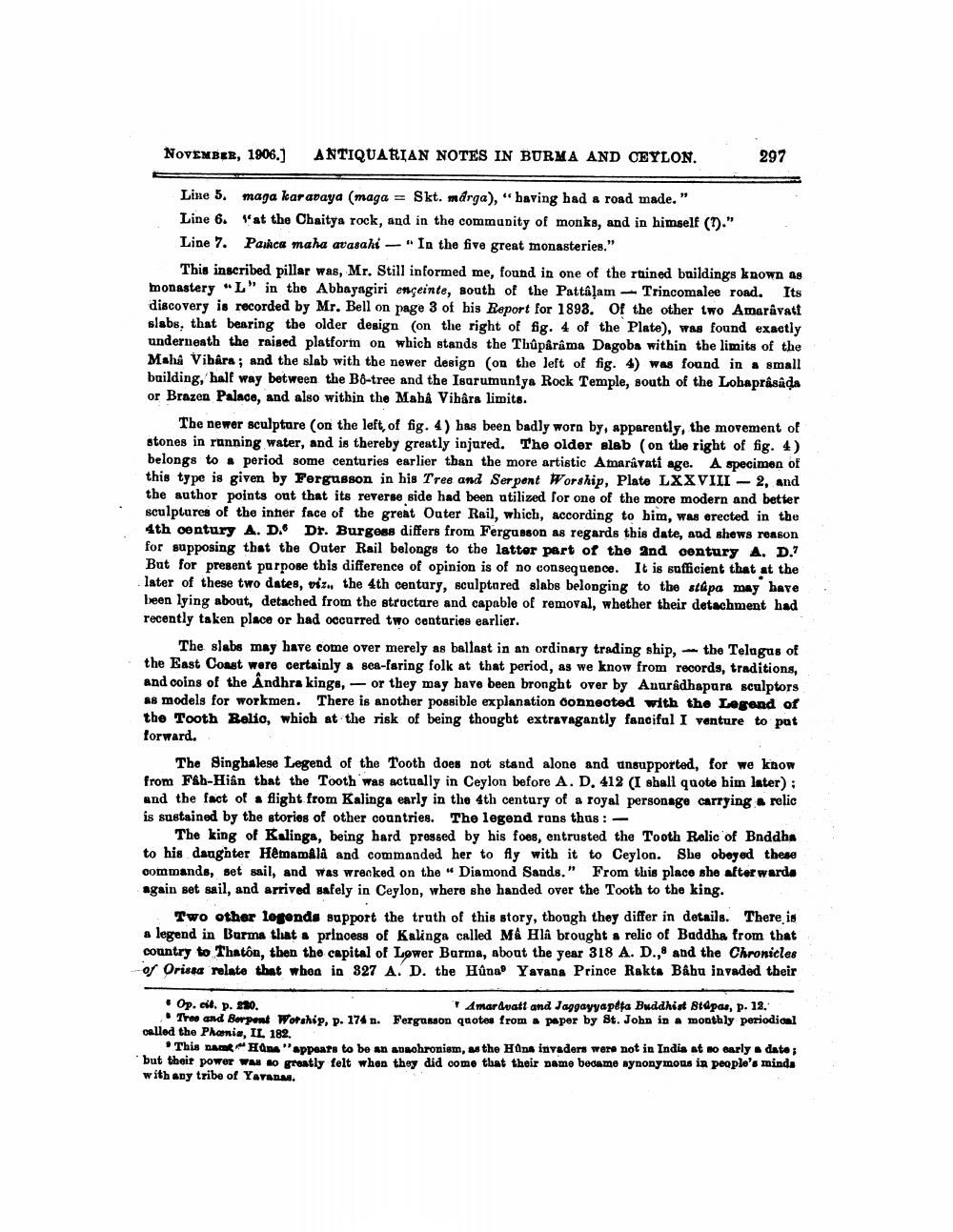________________
NOVEMBER, 1906.)
ANTIQUARIAN NOTES IN BURMA AND CEYLON.
297
Line 5. maga karavaya (maga = Skt. ndrga),“ baving had a road made." Line 6. at the Chaitya rock, and in the community of monks, and in himself (1)." Line 7. Panca maha avasaki - In the five great monasteries."
This inscribed pillar was, Mr. Still informed me, found in one of the ruined buildings known as monastery "L" in the Abbayagiri enceinte, south of the Pattâļam - Trincomalee road. Its discovery is recorded by Mr. Bell on page 3 of bis Report for 1898. Of the other two Amaravati slabs, that bearing the older design on the right of fig. 4 of the Plate), was found exactly underneath the raised platform on which stands the Thủpârâma Dagoba within the limits of the Maha Vihara ; and the slab with the newer design (on the left of fig. 4) was found in a small building, half way between the B6-tree and the Isarumuniya Rock Temple, south of the Lohaprasada or Brazen Palace, and also within the Maha Vihara limits.
The newer sculpture on the left, of fig. 4) has been badly worn by, apparently, the movement of stones in running water, and is thereby greatly injured. The older slab (on the right of fig. 4) belongs to a period some centuries earlier than the more artistic Amaravati age. A specimen of this type is given by Fergusson in his Tree and Serpont Worship, Plate LXXVIII - 2, and the author points out that its reverse side had been utilized for one of the more modern and better sculptures of the inner face of the great Outer Rail, which, according to him, was erected in the 4th century A. D. Dr. Burgess differs from Fergusson as regards this date, and shews reason for supposing that the Outer Rail belongs to the latter part of the 2nd century A. D.? But for present parpose this difference of opinion is of no consequence. It is sufficient that at the later of these two dates, viz. the 4th century, sculptored slabs belonging to the stúpa may have been lying about, detached from the structare and capable of removal, whether their detachment had recently taken place or had occurred two centuries earlier.
The slabs may have come over merely as ballast in an ordinary trading ship, the Telagas of the East Coast were certainly a sea-faring folk at that period, as we know from records, traditions, and coins of the Andhra kings, - or they may have been bronght over by Anuradhapura sculptors as models for workmen. There is another possible explanation connected with the Legend of the Tooth Belio, which at the risk of being thought extravagantly fanciful I venture to pat forward.
The Singhalese Legend of the Tooth does not stand alone and unsupported, for we know from Fib-Hiân that the Tooth was actually in Ceylon before A. D. 412 (I shall quote bim later): and the fact of flight from Kalinga early in the 4th century of a royal personage carrying a relic is sustained by the stories of other countries. The legend runs thus: -
The king of Kalinga, being hard pressed by his fons, entrusted the Tooth Relic of Bnddha to his daughter Hemamali and commanded her to fly with it to Ceylon. She obeyed these commands, set sail, and was wrecked on the Diamond Sands." From this place she after warda again set sail, and arrived safely in Ceylon, where she handed over the Tooth to the king.
Two other legends support the truth of this story, though they differ in details. There is a legend in Burma that a princess of Kalinga called M& HlA brought a relic of Baddha from that country to Thatôn, then the capital of Lower Barma, about the year 318 A. D., and the Chronicles of Orissa relate that when in 827 A. D. the Hûna Yavana Prince Rakta Babu invaded their
• Op. cit. p. 270.
Amarduatt and Jaggayyapeta Buddhist Btapas, p. 12. Tree and Berpent Worship, p. 174 n. Ferguson quotes from paper by St. John in a monthly periodical called the Phanie, IL 182.
This nam e appears to be an anachronism, as the one invaders were not in India at nearly dato; but their power was so greatly felt when they did como that their name became aynonymous in people's minda with any tribe of Yavana.




